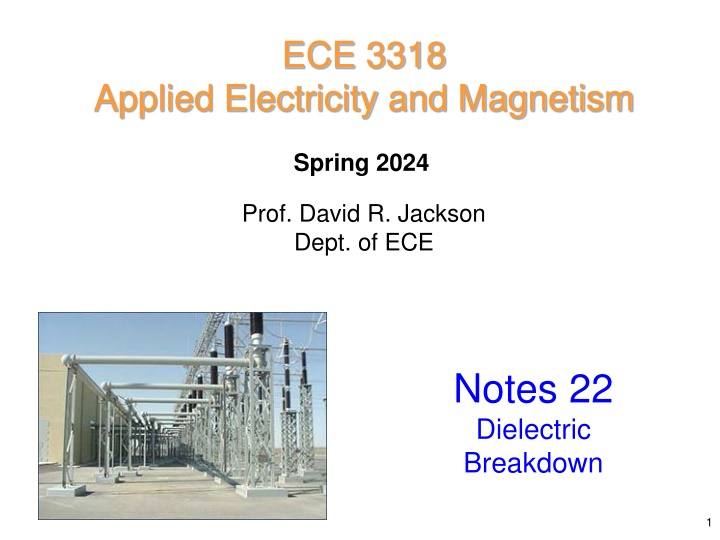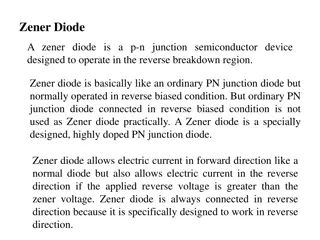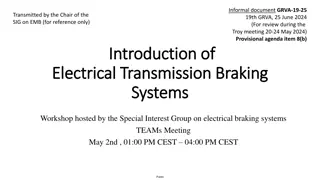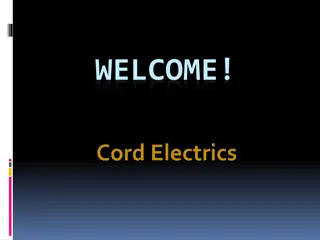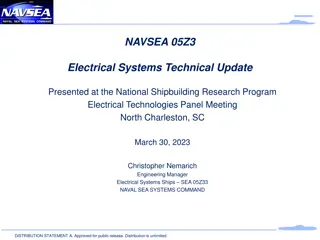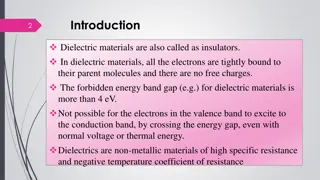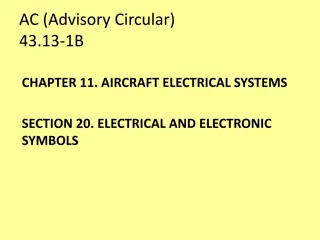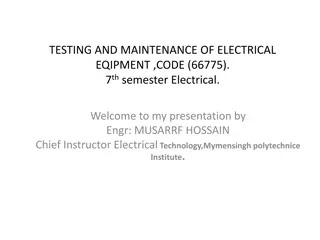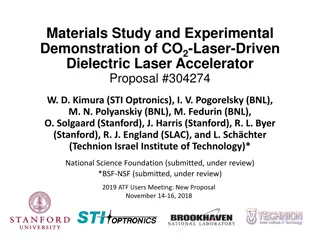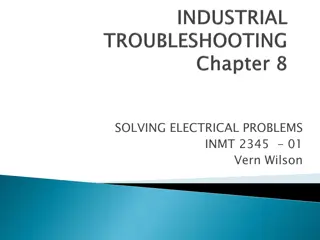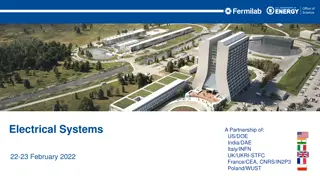Dielectric Breakdown in Electrical Systems
Exploring the phenomena of dielectric breakdown in electrical systems, including arcing, corona discharge, and the use of sulfur hexafluoride gas in circuit breakers. Detailed examples illustrate calculations for handling voltage in coaxial cables with safety factors.
Download Presentation

Please find below an Image/Link to download the presentation.
The content on the website is provided AS IS for your information and personal use only. It may not be sold, licensed, or shared on other websites without obtaining consent from the author.If you encounter any issues during the download, it is possible that the publisher has removed the file from their server.
You are allowed to download the files provided on this website for personal or commercial use, subject to the condition that they are used lawfully. All files are the property of their respective owners.
The content on the website is provided AS IS for your information and personal use only. It may not be sold, licensed, or shared on other websites without obtaining consent from the author.
E N D
Presentation Transcript
ECE 3318 Applied Electricity and Magnetism Spring 2024 Prof. David R. Jackson Dept. of ECE Notes 22 Dielectric Breakdown 1
Dielectric Breakdown 1 Arcing (spark) + - = x E E c E x c Spark Parallel-plate capacitor with uniform electric field 3 10 = 6 Air : V/m E c Ec = critical electric field = 15 10 6 Oil : V/m E The air ionizes and runaway (avalanche) breakdown occurs c = 30 10 6 Glass : V/m E c 2
Dielectric Breakdown (cont.) 2 Corona Discharge (local breakdown) + - E E c Bundled conductors tend to act like one larger conductor in terms of the breakdown. 400 kV high-voltage transmission line near Madrid, Spain (Wikipedia) Power lines are often grouped together ( bundled conductors ) to reduce conductor losses and the corona effect. 3
Dielectric Breakdown (cont.) Sulfur hexafluoride (SF6) gas is often used in large circuit breakers. Circuit breakers in 345 kV CenterPoint substation, Tomball, TX Atmospheric pressure = 101.325 kPa SF6 is often used for quenching arcs in circuit breakers. 4
Example = 2.0 r = 6 15 10 [ 0.25 ] c E b V/m r = = cm a 0.5 a mm Coaxial cable b Find: Vmax(assume a safety factor SF = 2) At breakdown: max ( ) l max = max E - 2 0 r - - + + + + Set = a (breakdown occurs here first): Note: + - + - - max l max = max sa ( ) a = = max E E 2 a c 2 l a max max l b = max sb 0 r 2 5
Example (cont.) = max 2 aE Thus 0 r c max a ( ) ( ) max = = max Hence E E E c 2 0 r B b max = = = max V V E dr E d We then have max AB A a b a = E d c a b = ln E a c a or b a = ln V E a max c 6
Example (cont.) Larger coaxes (larger a) can handle more voltage and power. With safety factor: 1 b a = SF max ln V E a c SF 1 2 ( ) ( ) ( ) ln 5 = 15 10 0.5 10 6 3 V = SF max 6035.4 V 7
Example (cont.) Phasor domain voltage Power flowing down the line: 2 ,SF p V 1 2 max Z = SF max P (from ECE 3317) 0 b a = [ ] ln 0 Z (derived later) 0 2 r Z = 68.3 0 This gives us W = SF max P 5 2.67 10 8
Van de Graaff Generator Principles: (1) Electric field is high near sharp points: the air is ionized and charges are free to jump on/off. (2) Faraday cage effect: No matter how much charge is placed on the dome, it goes to the outside and there is little field on the inside. The felt on the bottom pulley becomes positively charged. 9
Van de Graaff Generator (cont.) Dr. Robert J. Van de Graaff (1901-1967) was a professor at Princeton university and a Research Associate at MIT. The Van de Graaff generator was invented in 1929 and originally used as a research tool in early atom-smashing and high energy X-ray experiments. 10
Van de Graaff Generator (cont.) This picture shows Dr. Van de Graaff with his first generator (80 [kV]). 11
Van de Graaff Generator (cont.) Inside each dome there was a laboratory. The world s largest air-insulated Van de Graaff generator, designed and built by Van de Graaff during 1931-1933. The spheres are 15 feet in diameter and 43 feet off the ground. It can produce 7 [MV]. 12
Van de Graaff Generator (cont.) In the early 1950's, the giant Van de Graaff generator was donated to the Boston Museum of Science. For years, it was enclosed in a small steel structure on the Museum's property, where it was occasionally demonstrated. Finally, in 1980, the Thomson Theatre of Electricity was completed inside the museum. The generator is demonstrated at least twice daily, to teach public and school audiences about electricity and lightning. 13
Van de Graaff Generator (cont.) Boston Museum of Science 14
Van de Graaff Generator (cont.) A modern Van de Graaff generator integrated with a particle accelerator. The generator produces the high voltages (in the megavolt range) that accelerates particles. (from Wikipedia) 15
Van de Graaff Generator (cont.) For more information: http://en.wikipedia.org/wiki/Van_de_Graaff_generator 16
Van de Graaff Generator (cont.) Find the maximum voltage Vmaxon a Van de Graaff Generator in air Q = max E Point charge electric field formula: c 2 4 a 0 = 2 4 Q a E max max 0 c Q + + + + Q a ( ) r = max max + Point charge potential formula: 4 r 0 + + max V 2 4 Q a E a ( ) a = = = max max 0 c V + + max 4 4 a 0 0 == E E r c r a Hence = V aE max c (Assume zero volts at infinity.) A bigger dome can support a higher voltage! 17
Van de Graaff Generator (cont.) Find the maximum spark length to a grounded sphere + + Vmax + + a a + + + + h + = V E h max c V E h (parallel-plate approximation) max c The spheres are approximated as flat conductors. V E a E = = = = h a max E c h a c c 18
Van de Graaff Generator (cont.) Example Assume m Note: = 0.1 a This dimension corresponds to the small Van de Graaff that we have in the ECE Department. 3 10 = 6 E V/m c V = 300,000 V Maximum voltage max m = = 0.1 ( 3.9 [ ) h h ] inches Spark length 19
Tesla Coil This is used to produce high voltage at AC (typically about 1 [MHz]). 20
Tesla Coil (cont.) Equivalent circuit for a typical Tesla coil ( resonant air-core transformer ) = RF choke Spark gap (resonance) 1 2 + + 2 L 250 kV 500 KHz 6600 V (RMS) 60 Hz 120 V (RMS) 60 Hz 1L + - C 2 C V1 V2 1 1 1 = = 1 LC 2 - L C 1 1 - 2 2 Air-core transformer Step-up transformer V V L L = 2 2 At resonance: Output: 250 kV at 500 kHz 1 1 (Tesla coil in our lab) 21
Tesla Coil (cont.) Pictures of Tesla: (1) by himself; (2) in his lab with a Tesla coil; (3) lighting a lightbulb wirelessly. 22
Lightning 23
Lightning (cont.) Lightning strikes at George Bush Intercontinental Airport, June 12, 2012. Credit: texansgirl34 25
Lightning (cont.) Powerful air currents and friction between ice and water particles are believed responsible for the charge formation. The base of the thunder has negative charge and the top has positive charge (though there can be pockets of charge that are opposite). 26
Lightning (cont.) + + + + + + + + + _ _ _ _ _ _ _ _ _ Negative lightning + + + + + + + + + + + + + + + + + + + + + + + + + + + + + + + Earth Most lightning comes from negative charges at the base of a thundercloud (negative lightning). About 5% comes from the positive charges at the top (positive lightning). 27
Lightning (cont.) + + + + + + Positive lightning + + + _ _ _ _ _ _ _ _ _ + + + + + + + + + + + + + + Earth Positive lighting can be up to 10 times as powerful as negative lightning: it can result it a bolt from the blue, striking miles away from the visible cloud (up to 25 miles away or more). 28
Lightning (cont.) The different types of lightning that are usually observed are shown here. 29
Lightning (cont.) Positive lightning (note that it originates from the top of the cloud). 30
Lightning (cont.) + + + + + + + + + _ _ _ _ _ _ _ _ _ + + + + + + + + + + + + + + + + + + + + + + + + + + + + + + + Earth The base of the thundercloud is typically at an altitude of about 1,500 [m]. The top of the thundercloud may be at about 10,000 [m] or higher. The voltage drop between the cloud base and ground is typically 150 [MV]. This is not nearly enough to arc from the cloud to ground! 3.0 MV/m c E 31
Lightning (cont.) + + + + + + A stepped leader begins descending from the cloud. It is a group of electrons that zigzags toward the earth. The charge is typically about -5 [C]. + + + _ _ _ _ _ _ _ _ _ One theory is that cosmic rays are responsible for the formation of the leader, which ionize atoms and release electrons that get accelerated by the high electric fields. The stepped leader travels about 50 [m] in about 1 [ s], then pauses for about 50 [ s], and then continues, pausing every 50 [m] or so. The width of the leader channel is about 1.0 [cm]. The stepped leader does not know where it will strike until it is about 40 [m] or so from the earth. 32
Lightning (cont.) + + + + + + + + + _ _ _ _ _ _ _ _ _ The stepped leader may branch as it descends (this is responsible for the forked appearance of most lighting). Branches + + + + + + + + + + + + + + + + + + + + + + + + + + + + + + + Earth 33
Lightning (cont.) Main channel Branches 34
Lightning (cont.) File:Lightning formation.gif The pptx version has an animation (go to full-screen mode). http://en.wikipedia.org/wiki/Lightning 35
Lightning (cont.) As the stepped leader approaches the earth, positive streamers" rise up from the earth to meet it. + + + + + + + + + _ _ _ _ _ _ _ _ _ The streamers are more likely to come from conducting objects with sharp points (e.g., a lightning rod). Streamers may be up to about 50 [m] in length - - + + + + + + + + + + + + + + + + + + + + + + + + + + + + + + + + + + + + + Earth 36
Lightning (cont.) + + + + + + + + + _ _ _ _ _ _ _ _ _ At a height of about 40 [m] (up to about 50 [m]), a streamer meets with the stepped leader, and a conducting channel is formed to earth. - - Contact point + + + + + + + + + + + + + + + + + + + + + + + + + + + + + + + + + Earth 37
Lightning (cont.) A lightning flash terminates on a tree. (An un-attached streamer is visible on the earth surface projection to the left.) http://en.wikipedia.org/wiki/Lightning 38
Lightning (cont.) A powerful surge of current ( return stroke ) flows upward from the ground to the cloud. This is what is visible as the lightning bolt. + + + + + + + + + _ _ _ _ _ _ _ _ _ The current surge travels upward at about 25% the speed of light. The charge in the branches is drained as the surge passes by, lighting the branches as well. The peak current is typically 15 [kA] (sometimes reaching 100 [kA]). The return stroke typically lasts about 100 [ s]. - - - current surge + + + + + + + + + + + + + + + + + + + + + + + + + + + + + + + Earth 39
Lightning (cont.) The current typically stops for about 50 [ms]. + + + + + + + + + _ _ _ A new leader, called the dart leader usually descends from the cloud along the previous path. There is usually no branching as it goes. _ _ _ _ _ _ The dart leader travels about 10 times faster than the stepped leader, without pausing. It carries about -1 [C]. Another return stroke occurs when the dart leader reaches the ground. + + + + + + + + + + + + + + + + + + + + + + + + + + + + + + + Earth 40
Lightning (cont.) + + + + + + + + + The dart-leader / return-stroke combination typically repeats 3 or 4 times. _ _ _ _ _ _ _ _ _ The entire event (lighting flash) typically lasts 0.2 [s] (sometimes as long a 1 [s] or more). The total charge deposited on the ground (from the stepped leader, the dart leaders, and current flow between them) is about -25 [C]. + + + + + + + + + + + + + + + + + + + + + + + + + + + + + + + Earth 41
Lightning (cont.) + + + + + + + + + _ _ _ _ _ _ _ _ _ Lightning may not always strike the tallest object around! d 50 m d + + + + + + + + + + + + + + + + + + + + + + + + + + + + + + + Earth 42
Lightning (cont.) The rolling sphere method is often used to visualize what objects are vulnerable to being struck by lightning. Anything the sphere touches as it rolls is subject to being hit. This assumes that the maximum length of a streamer is 50 [m]. Rolling sphere 50 m Earth 43
Ground-to-Cloud Lightning + + + + + + + + + _ _ _ _ _ _ _ _ _ Ground-to-cloud lightning may occur, from objects that are very tall (like radio towers). + + + In this case a positive leader emerges from the object on the ground, and steps upward towards the cloud. + + + + + + + + + + + + + + + + + + + + + + + + + + + + + + + Earth 44
Ground-to-Cloud Lightning (cont.) Ground-to-cloud lightning (note the upward forking) 45
Lightning and Aircraft A commercial airplane is typically struck by lightning about once a year. The passengers are usually safe due to the Faraday cage effect. In about 10% of the cases, the airplane intercepts a leader that is traveling from the cloud (the plane gets in the way of the lightning). In about 90% of the cases, the airplane initiates the lightning strike: The leader emerges from the plane. This is often in the form of a bi-directional leader. In the bi-directional leader, a positive leader emerges from the top of the plane, and shortly after a negative leader emerges from the bottom of the plane (which is now negatively charged). 46
Lightning and Aircraft (cont.) + + + + + + + + + Plane stuck by lightning while on takeoff from the Komatsu Air Force Base off the coast in the Sea of Japan. _ _ _ _ _ _ _ _ _ Upward-going positive leader (note upward branching) Downward-going negative leader (note downward branching) 47
Lightning Rod A lighting rod is a rod of metal that is well grounded, and ideally fairly sharp at the end. The taller the better. It launches a good streamer (better than the surrounding points on the building) because of the high electric field near the tip. It should be well grounded to discharge safely a lighting strike. + + + + + + + + + _ _ _ _ _ _ _ _ _ Positive streamer High electric field + + + + + + + + + + + + + + + + + + + + + + + + + + + + + + + Earth 48
Laser Lightning Rod Experimental study in the Swiss Alps to see if a high-power laser beam can act as a lightning rod (by ionizing the air). Heather M. Hill, Lightning strikes a laser rod, Physics Today, Jan. 25, 2023, DOI:10.1063/PT.6.1.20230125a 49
Laser Lightning Rod (cont.) Results appear to be promising! 50
